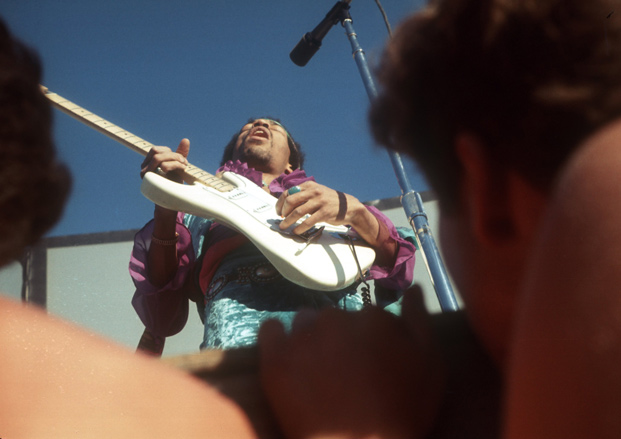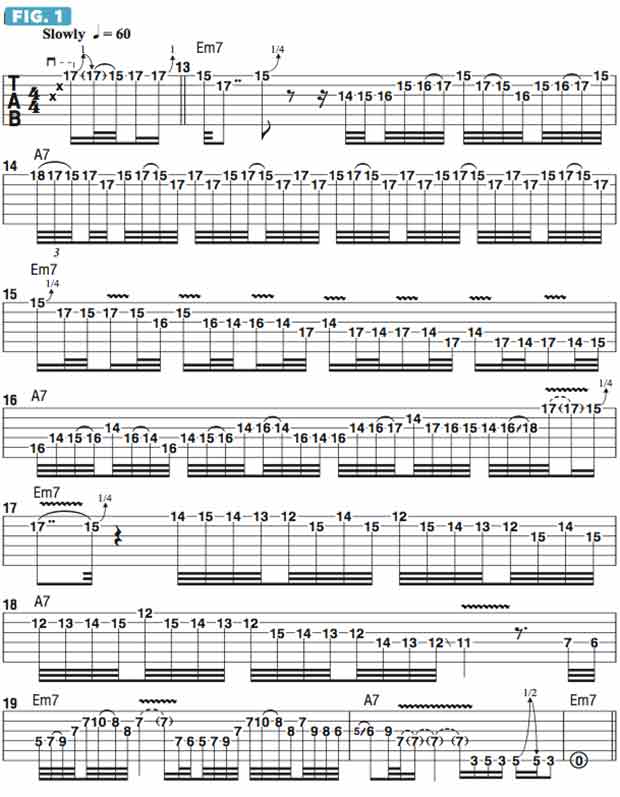How to Build Intensity When Soloing at a Slow Tempo
Give your solos an emotional quality and appeal.

Last time, I presented 12 bars of original soloing over a laid-back two-chord vamp—Em7 to A7—reminiscent of that heard in Pink Floyd's “Breathe” and Stevie Ray Vaughan’s “Riviera Paradise.”
As you might recall, I started off slowly, with lots of long, sexy bends, which I attacked with muted string rakes for an accentuated, dramatic effect and adorned with finger vibratos to make the held notes really sing, in an effort to give the solo an emotional quality and appeal.
As the solo unfolded, I started introducing faster, “busier” 16th- and 32nd-note rhythms in short bursts, using legato techniques such as quick bends, releases, hammer-ons and pull-offs in combination to produce slinky, Eddie Van Halen–style phrases. This time, I’m going to continue developing the solo rhythmically and melodically and demonstrate how to build density and intensity by playing long 32nd-note lines that work nicely over both chords.
FIGURE 1 picks up with the end of bar 12 from last month’s example, which serves as a lead-in to bar 13, which I begin with a syncopated accent on the E root note, adding a fierce finger vibrato to it to help kick the energy level up a notch.
I follow this with a subtle, soulful quarter-step bend, or “curl,” on the G note above it (high E string, 15th fret), then take a brief pause, or “breath,” offering a moment of silence before launching into a long, blistering 32nd-note run based on the E blues scale (E G A Bb B D).
I use D#, the major seventh, as an added chromatic passing tone between D, the minor seventh, and the E root in a way that is similar to the intro of Jimi Hendrix’s “Manic Depression,” albeit in a different key, register and rhythmic context. The run in bar 14 is proudly inspired by one of Jimmy Page’s signature blues-rock “burst licks.”
It features lightning-fast pull-offs, à la the live versions of the dramatic Led Zeppelin slow-jam songs “Since I’ve Been Loving You” and “No Quarter” on The Song Remains the Same. Here, I’m specifically going for the way Page creates a compelling feeling of rhythmic intensity and tension by repeating three notes in a syncopated phrasing scheme in which the highest note “pops” on a different part of the beat each time it’s picked.
I follow this in bar 15 with a cascading E minor pentatonic lick (E G A B D), using a “gallop”-rhythm motif—a 16th note followed by two 32nd notes—that moves across the neck to the lower strings and accentuates the “triple-time” feel I’m going for. This leads into a rolling 32nd-note climb back up across the strings over the A7 chord in bar 16, a run inspired by Dickey Betts’ country-flavored soloing style and based on the A major blues scale (A B C C# E F#), with an F chromatic passing tone added between E and F# on the D string’s 15th fret.
Following another phrasing pause in bar 17, I launch into a Steve Morse–inspired, rapid- fire alternate-picking run, beginning on an upstroke to optimize the string crosses with "outside-the-strings” picking. Using the 12th-position E minor pentatonic “blues box” as a loose framework, I liberally add chromatic passing tones between targeted chord tones of Em7 and A7 to create a rolling contour. Finally, I take a jazzy turn in bar 19 with a Michael Brecker–inspired Em9 arpeggio lick (E G B D F#), infused with chromatic passing tones and repeated in an offset rhythm.
I then wind down the solo with a slower, lower-pitched melody that works its way down to the open low E note.

Get The Pick Newsletter
All the latest guitar news, interviews, lessons, reviews, deals and more, direct to your inbox!
Over the past 30 years, Jimmy Brown has built a reputation as one of the world's finest music educators, through his work as a transcriber and Senior Music Editor for Guitar World magazine and Lessons Editor for its sister publication, Guitar Player. In addition to these roles, Jimmy is also a busy working musician, performing regularly in the greater New York City area. Jimmy earned a Bachelor of Music degree in Jazz Studies and Performance and Music Management from William Paterson University in 1989. He is also an experienced private guitar teacher and an accomplished writer.
“There are so many sounds to be discovered when you get away from using a pick”: Jared James Nichols shows you how to add “snap, crackle and pop” to your playing with banjo rolls and string snaps
Don't let chord inversions bamboozle you. It's simply the case of shuffling the notes around








![Joe Bonamassa [left] wears a deep blue suit and polka-dotted shirt and plays his green refin Strat; the late Irish blues legend Rory Gallagher [right] screams and inflicts some punishment on his heavily worn number one Stratocaster.](https://cdn.mos.cms.futurecdn.net/cw28h7UBcTVfTLs7p7eiLe.jpg)


